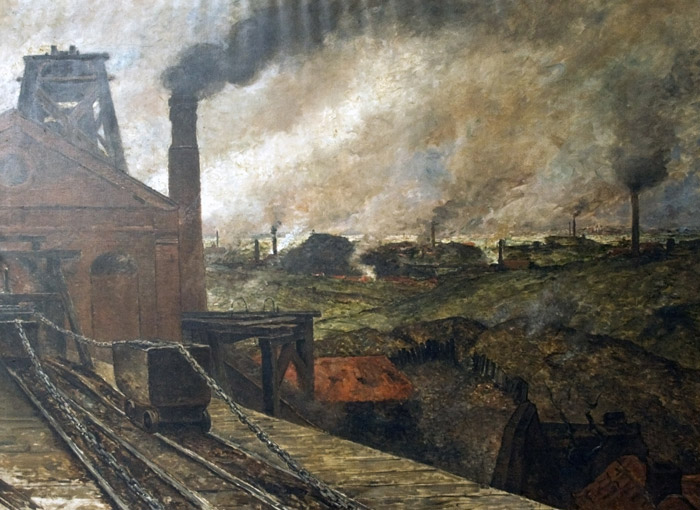Hole in the Clouds
Jul 8, 2014
 The Black Country of Belgium is the Borinage district of Wallonia province, where coal was mined to feed the furnaces of the Industrial Revolution from the 1820s until the 1960s.
The Black Country of Belgium is the Borinage district of Wallonia province, where coal was mined to feed the furnaces of the Industrial Revolution from the 1820s until the 1960s.
The countryside was devastated by slag heaps, ash ponds, and smokestacks, and life in and around the mines was brutal. For more than a century, the miners of Borinage organized labor actions that were violently suppressed; in the 1930s, the mine owners evicted strikers from their homes, and families spent the winter sleeping in the streets while soldiers guarded the empty houses.
Since the last of the mines closed in the 1960s, Borinage has been characterized by Belgium's highest unemployment rates.
Constantin Meunier was a Belgian painter and sculptor of the late nineteenth century whose work often focused on the social impact of industrialization. This painting is believed to date to about 1893.
Belgium
oil
ruins
industry
coal mining
1893
Wallonia
smokestack
Borinage
(Painting by Constantin Meunier)
Mar 26, 2017
 The truth is not hard to believe: these guys were in fact trying for a world record in 1893 when they loaded the sled with more than 36,000 board feet of virgin white pine logs from Ontanagon County in the Upper Peninsula of Michigan.
The truth is not hard to believe: these guys were in fact trying for a world record in 1893 when they loaded the sled with more than 36,000 board feet of virgin white pine logs from Ontanagon County in the Upper Peninsula of Michigan.
How did they pile up the load so high? The horses actually did much of the work. The men would lay each log on the ground longside the sled and affix ropes to it that went up and over the load and then back down to the ground on the other side of the sled. That's where the horses were waiting; they would be harnessed to the ropes, and as they were led away from their side of the sled, the ropes would pull the new log up to the top of the heap, guided up the side by angled tracks made from small logs. When the new log reached the top, the men would snag it into place.
How come the sled didn't just sink down in the snow? An ice road had been specially prepared, with the snow sprayed repeatedly with water and allowed to freeze rock-hard. The horses had special shoes with crampons that bit into the ice surface.
Usually, logs hauled this way were taken to a frozen river, awaiting spring, when they'd be floated downstream to a sawmill. But this particular load was pulled for just half a mile by these two horses, to a railroad siding, where the logs and the sled were loaded onto freight cars and shipped to Chicago.
There, at the Michigan pavilion of the 1893 Columbia Exhibition, the load was reassembled, sled and all, treating fairgoers to a glimpse of logging activity in what was then the world's busiest lumber region.
Did they make it into the Guinness Book of Records? We have no idea, but they did claim this was the largest load of lumber in the history of the world.
Note that most of the men here had no gloves, and of course none of them had hard hats.
Chicago
Michigan
logging
winter
horses
work
sled
forest
1893
Ontanagon County
Columbia Exhibition
Upper Peninsula
world record
(Image credit: Detroit Publishing Co via Shorpy)
 The Black Country of Belgium is the Borinage district of Wallonia province, where coal was mined to feed the furnaces of the Industrial Revolution from the 1820s until the 1960s.
The Black Country of Belgium is the Borinage district of Wallonia province, where coal was mined to feed the furnaces of the Industrial Revolution from the 1820s until the 1960s.